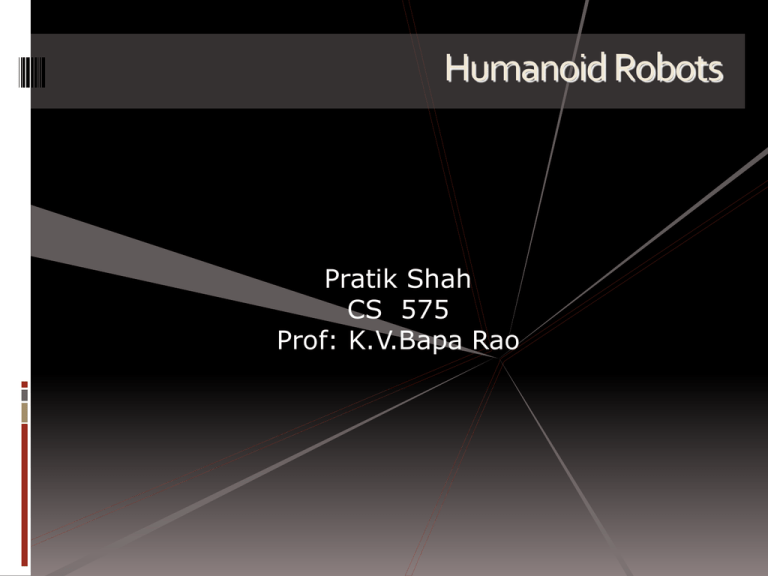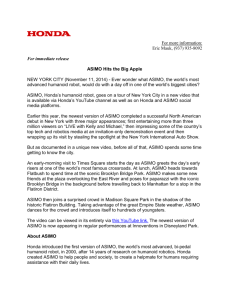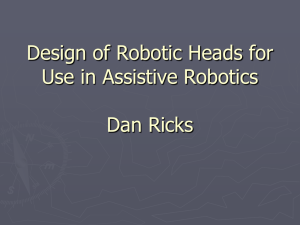Humanoid Robots
advertisement

Humanoid Robots Pratik Shah CS 575 Prof: K.V.Bapa Rao Outline What is a robot? History Our Times Why Humanoid Robots? ASIMO Recognition Technology Conclusion What is a Robot?? “A reprogrammable, multifunctional manipulator designed to move material, parts, tools, or specialized devices through various programmed motions for the performance of a variety of tasks." Robot Institute of America, 1979 “Where AI (Artificial Intelligence) meets the real world.” History Early Stages The notion of putting machines to work can be credited to great thinkers like Aristotle. Westinghouse Electric Corp. creates two of the first robots that use the electric motor for entire body motion. History (cont.) 1968…’Shaky’ build at Stanford Research Institute. Shakey could perform tasks that required planning, route-finding, and the rearranging of simple objects. Our Times In 1997 the P3 robot was produced by Honda which was more human like. Capabalities: Walk around Climb stairs Carry things Pick things up Push things Position it self accurately Our Times (cont.) In 2000 Honda incorporated the P3 technology into its dancing robot ASIMO. Why Humanoids?? Are there any good reasons for doing research on humanoid robots? Work in dangerous environments Exhaustive and repetitive tasks. Division of labour with humans in cooperative tasks Anthropomorphism Embodiment Interaction and Communication Why Humanoids?? Anthropomorphism Humans have built complex environments, tools and equipments very much adapted to our selves. Robots with human-like morphology and motion capabilities have a greater potential acting in living environments created for humans, than e.g. wheeled robots. Why Humanoids?? Embodiment The form of our bodies is critical to the representations that we develop and use for both our internal thought and our language. If we are to build a robot with human like intelligence then it must have a human like body in order to be able to develop similar sorts of representations. Why Humanoids?? Important aspects of being human are interaction and communication with other humans. Humanoids can communicate in a manner that supports the natural communication modalities of humans. Examples include: facial expression, body posture, gesture, gaze direction, and voice. If a robot has humanoid form, then it will be both easy and natural for humans to interact with it in a humanlike way. Who is ASIMO? ASIMO is a humanoid robot created in 2000 by Honda. ASIMO stands for Advanced Step in Innovative MObility 11th in line of successive bipedal humanoid model’s by Honda. It is the 4th man like humanoid robot. Specifications Weight: 52 kilograms Running Speed: 6 km/h Walking speed: 2.7 km/h Walking speed while carrying objects: 1.6 km/h Height: 130 cm Width: 45 cm Depth: 44 cm Continuous operating time: 40 min – 1 hr Degrees of Freedom: 34 Why was ASIMO created? Why was ASIMO created? Recognition Technology With 2000's ASIMO model Honda added many features, labelled "Intelligence Technology", that enable ASIMO to interact better with humans. These features fall under 5 categories: 1. Recognition of moving objects 2. Posture/gesture recognition 3. Environment recognition 4. Sound recognition 5. Face recognition. Recognition of moving objects ASIMO can detect movement of multiple objects, assessing distance and direction using the visual info. captured by the camera. Featured served by this application are Follow the movements of people Follow a person Yield to pedestrians in its path. Greet a person when he or she approaches. Recognition of postures and gestures Positioning and movement of a hand, recognizing postures and gestures. Can react and be directed to both voice commands and natural movements of human being. Recognize when a handshake is offered. A person waving at it. Movement directions. Environment recognition ASIMO can recognize the objects and terrain of his environment and act in a way that is safe for both himself and nearby humans. Recognizing potential hazards such as stairs. Avoid hitting humans and other moving objects. Distinguishing sounds ASIMO can distinguish between voices and other sounds. He can respond to his name, face people when being spoken to, and recognize sudden, unusual sounds such as that of a falling object or a collision, and face in that direction. Facial recognition ASIMO has the ability to recognize faces, even when ASIMO or the human being is moving. It can individually recognize approximately 10 different faces. Once they are registered it can address them by name. Demo ASIMO at CES 2007 in Las Vegas. ASIMO conducts Detroit Symphony Orchestra Conclusion History of humanoid robot Reasons for its existence ASIMO And now The Big Question?? The Big Question Should the human race be worried by the rise of robots? Why do you ask? Isn't all this just sci-fi fantasy? What else is about to be invented? What's all this about 'robot rights'? But do these changes raise moral issues? So are these machines a threat? Yes… The Japanese are trying to create a robot that will take over child minding and care of the elderly from human beings The Koreans are working on a robot sentry that can distinguish the movement of people and shoot them on sight The US military have commissioned a robot helicopter with a recoil-less rifle capable of tracking and killing a particular individual So are these machines a threat? No… Robots are taking over tasks which are deemed dull, dirty and dangerous The idea of robots with greater intelligence than humans is at least 50 years away, and may never come It's not the robots we need to worry about; it's the people who programme them References Honda Asimo Website History of humanoid robots part 1 History of humanoid robots part 2 Thank you!!




